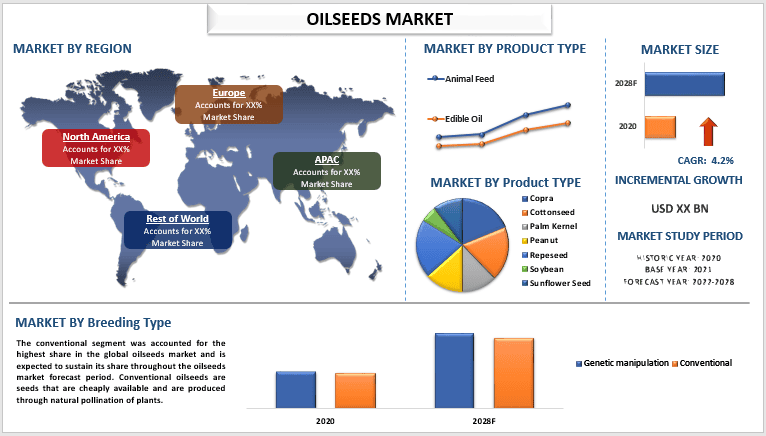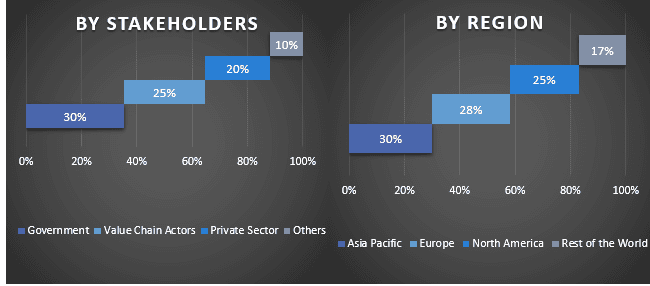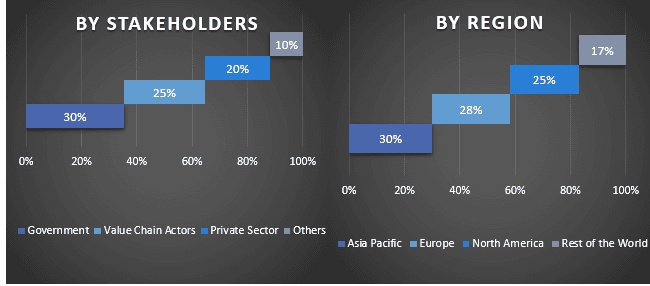Emphasis on Oilseeds Type (Copra, cottonseed, Palm Kernel, Peanut, Repeseed, soybeans, and sunflower seed); Product Type (animal Feed and edible Oil); Breeding Type (genetic manipulation and conventional); and Region/Country

The Oilseeds Market was valued at more than USD 244.11 billion in 2020 and is expected to grow at a CAGR of around 4.2% from 2022-2030.
Oilseeds are the seeds used to cultivate oil crops such as sunflower, soybean, canola, and cotton. The seeds, fruits, or nuts of these oil crops are either consumed directly as food or crushed to extract oil for food, biofuel, oleo chemicals, and other industries. The demand for oilseeds is mainly driven by the growing demand for vegetable oils in the increasing number of households. Owing to the continuous increase in demand for oilseed extracts, farmers are investing in the production of oil crops with high-quality oilseeds. Moreover, the rising need for biofuels in developing as well as developed countries is triggering the growth of the oilseeds market. To fulfill the ever-growing demand for oil across the globe, farmers are inclining toward adopting genetically modified oilseeds to increase yield. Some of the reasons driving the growth of the oilseeds market include the need for healthy and organic oilseed-processed goods, public-private collaborations in varietal development, and molecular breeding in oilseeds. For instance, Government of India to launch an oilseed mission to boost domestic production of oilseeds and reduce import dependence. The scheme is expected to have elements like subsidy to farmers for buying good quality seeds, intervention by the government in the market to support prices when needed, and involvement of the private sector in making available quality seeds.
Some of the major players operating in the market include ADM, BASF SE, Bayer AG, Burrus Seed, Cargill Incorporated, Corteva, Gansu Dunhuang Seed Industry Group Co., Ltd., KWS SAAT SE & Co. KGaA, Mahyco Seeds, Syngenta Crop Protection AG.
Insights Presented in the Report
“Amongst type, sunflower category to witness higher CAGR during the forecast period”
Based on oilseeds type, the market is segmented into oilseeds copra, cottonseed, palm kernel, peanut, repeseed, soybeans, and sunflower seed. Sunflower category is expected to grow at high CAGR during the forecast period. Sunflower oil is extensively used as frying oil in food and as a lubricant in cosmetic applications. It contains linoleic acid, a polyunsaturated fat and oleic acid, a monounsaturated fat and consists of huge amounts of Vitamin E. When sunflower oil is extracted, the crushed seeds are left behind, which are high in protein and dietary fiber and can be utilized as animal feed, fertilizer, or fuel.
“Amongst product type, animal feed to hold a significant share in the market in 2020”
On the basis of product type, the market is segmented into animal feed and edible oil. The animal feed segment was the highest contributor to the market in 2020. Meat, seafood, poultry, and milk continue to make vital contributions to global food supply and, as a result, animal feeds have become a significant component of the integrated food chain. Oilseed meal, which is a by-product of processed oilseeds after extraction of oil, is used extensively in animal feeds, and is therefore a vital economic aspect of oilseed production.
“North America expected to dominate the market in soybean segment”
North America leads the oilseed market with a large market share in 2021. This is due to the increased use of cooking oil in regular cooking, which increases oilseed production. In Canada, soybean was the largest segment because of the high demand from other countries, and the country exported about 4.4 million ton of soybeans in 2020, an increase of 418,979 ton from 4.0 million ton in 2019. Therefore, more seeds will be required in the future to meet the demand of other countries and domestic demand.
Reasons to buy this report:
Customization Options:
The global Oilseeds market can further be customized as per the requirement or any other market segment. Besides this, UMI understands that you may have your own business needs, hence feel free to connect with us to get a report that completely suits your requirements.
1. Market Introduction
2. Research Methodology Or Assumption
3. Market Synopsis
4. Executive Summary
5. Impact Of Covid-19 On The Oilseeds Market
6. Oilseeds Market Revenue (usd Bn), 2020-2030f
7. Market Insights By Oilseeds Type
8. Market Insights By Product Type
9. Market Insights By Breeding Type
10. Market Insights By Region
11. Oilseeds Market Dynamics
12. Oilseeds Market Opportunities
13. Oilseeds Market Trends
14. Demand And Supply-side Analysis
15. Value Chain Analysis
16. Competitive Scenario
17. Company Profiled
18. Disclaimer
Research Methodology for the Oilseeds Market Analysis (2022-2030)
Analyzing the historical market, estimating the current market, and forecasting the future market of the global Oilseeds market were the three major steps undertaken to create and analyze the adoption of Oilseeds market in major regions globally. Exhaustive secondary research was conducted to collect the historical market numbers and estimate the current market size. Secondly, to validate these insights, numerous findings and assumptions were taken into consideration. Moreover, exhaustive primary interviews were also conducted, with industry experts across the value chain of the global Oilseeds market. Post assumption and validation of market numbers through primary interviews, we employed a top-down/bottom-up approach to forecasting the complete market size. Thereafter, market breakdown and data triangulation methods were adopted to estimate and analyze the market size of segments and sub-segments of the industry pertains to. Detailed methodology is explained below:
Analysis of Historical Market Size
Step 1: In-Depth Study of Secondary Sources:
Detail secondary study was conducted to obtain the historical market size of the oilseeds market through company internal sources such as annual reports & financial statements, performance presentations, press releases, etc., and external sources including journals, news & articles, government publications, competitor publications, sector reports, third-party database, and other credible publications.
Step 2: Market Segmentation:
After obtaining the historical market size of the Oilseeds market, we conducted a detailed secondary analysis to gather historical market insights and share for different segments & sub-segments for major regions. Major segments are included in the report as oilseeds type, product type, and breeding type. Further country-level analyses were conducted to evaluate the overall adoption of testing models in that region.
Step 3: Factor Analysis:
After acquiring the historical market size of different segments and sub-segments, we conducted a detailed factor analysis to estimate the current market size of the Oilseeds market. Further, we conducted factor analysis using dependent and independent variables such as oilseeds type, product type, and breeding type of Oilseeds market. A thorough analysis was conducted for demand and supply-side scenarios considering top partnerships, mergers and acquisitions, business expansion, and product launches in the Oilseeds market sector across the globe.
Current Market Size Estimate & Forecast
Current Market Sizing: Based on actionable insights from the above 3 steps, we arrived at the current market size, key players in the global Oilseeds market, and market shares of the segments. All the required percentage shares split, and market breakdowns were determined using the above-mentioned secondary approach and were verified through primary interviews.
Estimation & Forecasting: For market estimation and forecast, weights were assigned to different factors including drivers & trends, restraints, and opportunities available for the stakeholders. After analyzing these factors, relevant forecasting techniques i.e., the top-down/bottom-up approach were applied to arrive at the market forecast for 2028 for different segments and sub-segments across the major markets globally. The research methodology adopted to estimate the market size encompasses:
Market Size and Share Validation
Primary Research: In-depth interviews were conducted with the Key Opinion Leaders (KOLs) including Top Level Executives (CXO/VPs, Sales Head, Marketing Head, Operational Head, Regional Head, Country Head, etc.) across major regions. Primary research findings were then summarized, and statistical analysis was performed to prove the stated hypothesis. Inputs from primary research were consolidated with secondary findings, hence turning information into actionable insights.
Split of Primary Participants in Different Regions

Market Engineering
The data triangulation technique was employed to complete the overall market estimation and to arrive at precise statistical numbers for each segment and sub-segment of the global Oilseeds market. Data was split into several segments & sub-segments post studying various parameters and trends in the areas of oilseeds type, product type, and breeding type in the global Oilseeds market.
The main objective of the Global Oilseeds Market Study
The current & future market trends of the global oilseeds market were pinpointed in the study. Investors can gain strategic insights to base their discretion for investments on the qualitative and quantitative analysis performed in the study. Current and future market trends determined the overall attractiveness of the market at a regional level, providing a platform for the industrial participant to exploit the untapped market to benefit from a first-mover advantage. Other quantitative goals of the studies include:

Customers who bought this item also bought